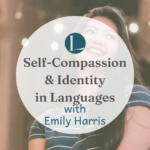April 27th, 2023
The Best Way to Learn a Language for Successful Results
What’s the best way to learn a language? There’s so many ways to learn a language that it can be overwhelming knowing what you actually need, what’s nice to have, and what you can forget and scrap from your plans. In this article, we’ll compare three core methods you might be considering: language specific courses, free apps, and my program Language Life.

What’s the Best Way to Learn a Language for Successful Results?
Before we get started, you can enjoy this episode in the way you prefer. We’ve got a video version and the podcast below. So pick your place and let’s go!
The Video
The Podcast
Best Way to Learn a Language: Option 1
Language Specific Courses
Whether it’s a teacher-led class, a self-study course or a teach yourself book, you’ll likely be drawn to language specific courses. For obvious reasons. You want to learn a language so you need something that will teach you that language, right? Maybe.
Let’s consider the pros and cons of this approach.
Pros of Language Specific Courses
Range of pricing options to suit your budget
You can hop onto eBay right now or head down to your local charity shop and try your luck at finding a French textbook.
The option is there to book a package of online classes with an Arabic teacher to focus on getting the basics down.
You could splurge on that summer Spanish program in Barcelona that you’ve had your eye on for a while.
Whatever your budget, there’s language specific materials out there for you. This is one of the big benefits of language specific courses – for many languages, there’s so much to choose from that you end up with a range of pricing options to suit your budget. Yay!
Reviews often easy to find
On tutor marketplace sites, Amazon, blogs, YouTube…it can be really easy to do your research on language specific courses to figure out which one will suit you best.
The tricky thing here worth bearing in mind is that affiliate links exist. An affiliate link means that a website owner gets a percentage of a sale if you purchase something through their link.
That means that sometimes, you might find a review online that can’t praise an online course highly enough (because the more people buy through their link, the more affiliate money they make too).
So you buy it. And you’re disappointed.
Affiliate links aren’t a bad thing – I use them myself for Lindsay Does Languages. Referrals are really normal & useful – think about the last time a friend recommended a great restaurant that (in their words) will “blow your mind”.
But affiliate links can lead to biased reviews online. It’s the reason I stopped doing reviews for products many years ago.
Gives you the content you (probably) need to learn
If you’ve picked the right course for you (a mission in itself sometimes), then you’ll hopefully get lucky and have the content that you probably need to learn in front of you.
The vocab, the grammar structures, the scenarios you’re likely to encounter.
Hopefully it’s all there in front of you just waiting for you to take it in. More on this in a moment.
Cons of Language Specific Courses
Overwhelm of choice leads to FOMO
The sheer range of options with language specific courses can lead to total overwhelm before you’ve even picked one. And then FOMO (fear of missing out) when you do pick something and wonder what you’re missing by not picking the others.
How do you know if you’ve picked the right or wrong resource? You often don’t until it’s too late. When you’re chapters in and wondering “Should I plow through this terrible German course and finish or just give up now and start with something else?”
And then when you opt to give it up and find a shiny new German course, it starts from scratch. So yet again you’ve got lessons on Guten Tag to get through before you catch up to where you were.
It can be exhausting.
How to Counter This
Set yourself a deadline when picking language resources. Do the research on key points that matter to you (do you want to speak only or do you need a fuller picture of grammar to pass an exam?).
When the deadline comes, pick a resource, stick to it, and continue to learn how to best use any resource.
Remember: there’s no such thing as ‘the best language resource’. So don’t be sold on gimmicky marketing or reviews only. Pick something that fits your budget, your timeframe of study, your routine.
You can learn a language successfully with any resource when you know how to use it.
Less available for lesser studied languages
So far we’ve talked about what happens when there’s too much choice of language specific courses. But that’s not always the case. What’s the best way to learn a language when there’s not many resources out there?
There’s often less available for lesser studied languages. It just doesn’t pay for a company to make a course for Guarani or Ainu or Farsi when they know they’ll sell more of German or Arabic or French.
This can leave learners of lesser studied languages with an often out-dated mix of photocopied PDF grammar guides written for linguists, and website vocab lists from the early 2000s.
There’s nothing wrong with that mix on one condition: that you know how to learn a language. More on that later.
How to Counter This
Much like the previous point, this is all about knowing how to learn a language. When you’re confident in that area, you can learn any language with limited resources because you’ll know what to do with it.
Spend some time getting familiar with the best ways to learn a language for yourself. Then you’ll be ready to learn any language with any resource.
Content not always relatable
I said that a pro of language specific courses can be that the content you want and need is right there for you. However, this isn’t always what happens.
Sometimes you end up with dialogues about Mr Smith going to Spain for a business trip or Miss Jones heading to Indonesia on a student visa. Which is fine if that’s your reason for learning. In that case, you’ve found your best way to learn a language. Yay!
But for the rest of us, that sort of content can feel stale and boring. And when language learning gets stale and boring? Well, it’s far too easy to lose motivation and give up.
How to Counter This
It begins with de-centring yourself from the resource you’re using. You may not be Mr Smith going to Spain on a business trip, but someone is. And that’s ok. It doesn’t mean this resource isn’t for you.
The next step is to re-centre yourself. Ask yourself what you’d like to see differently in the resource instead. How would you alter that dialogue in chapter 3 for your own more likely scenario?
How to Get Started
There’s so many language specific options out there that it would be impossible to list them all! So I’ll list the ones I know, am an affiliate for and have tried myself.
Gymglish make great language specific courses for French, English, Spanish, German and Italian. I wrote more about their courses and how to pick your next online language course here.
The LanguagePod101 (sometimes Class101) series offer a great range of languages. I used this a lot for Japanese. They have options for Afrikaans, Arabic, Bulgarian, Cantonese, Chinese, Czech, Danish, Dutch, English, Filipino, Finnish, French, German, Greek, Hebrew, Hindi, Hungarian, Indonesian, Italian, Japanese, Korean, Norwegian, Persian, Polish, Portuguese, Romanian, Russian, Spanish, Swahili, Swedish, Thai, Turkish, Urdu, Vietnamese.
Learning Portuguese? Mia Esmeriz has a great range of options for various levels.
If Spanish is your language of choice & you love music, then definitely check out Learn Spanish Con Salsa.
Beyond that, have a good look around and pick what feels like the right fit for you if this is something you’re interested in.
Best Way to Learn a Language: Option 2
Free Language Apps (and maybe paid for ones too)
It’s so great that language learning has become accessible to so many more people through apps. And often made (seemingly) more fun too. However, there’s two sides to this to consider when it comes to establishing the best way to learn a language.
Let’s consider the pros and cons of this approach.
Pros of Free Language Apps
Free or often low priced options make it easy to start
We’ve all heard of (and probably downloaded and tried) Duolingo. It’s fun, cute, easy, quick, and best of all…free. (Unless you want to upgrade to Super Duolingo or Duolingo Max).
This makes it super easy to get started learning a language due to the lack of a financial barrier.
Even if you do decide to go for a paid for version of an app, chances are it’ll be relatively low priced. So you can spend your language budget on other things. Win!
Easy to fit into your busy day
Let me guess…you’re either reading this on your phone, or your phone is within your vicinity?
Love it or hate it, our phones are a part of our modern life. That means that language apps are really easy to fit into our day, making them a great contender for the best way to learn a language.
Feels rewarding
That ease of use and speed of a lesson can feel really rewarding. Those little dopamine hits we get when the green Duolingo owl tells us we did good, or those Drops motivation notes pop up work!
When we feel like we’re succeeding, we want to do more. And these apps put lots of time, money & research into finding out exactly what makes us feel like we’re succeeding.
Rewards, virtual coins, a unicorn flying across the screen on a rainbow. All of these things can contribute to us feeling like it’s time well spent and therefore we want to use the app more.
Cons of Free Language Apps
Overwhelm of choice leads to FOMO
It has to be said, much like language specific courses, there’s a lot of free language apps out there nowadays.
Should you use Memrise or Clozemaster? Is it worth paying for LingQ or LyricsTraining? Does Mondly work better than Busuu? Will Babbel be worse for me than Rosetta Stone? Argh!
Sifting through your options can again lead to total overwhelm and FOMO when it comes to picking the best way to learn a language.
And once you’ve picked one, for some of us we get that feeling of the need for completion. This means it’s easy to spend too much time with an app that isn’t working productively for us.
How to Counter This
Much like the advice for how to counter this with language specific courses, set yourself a research deadline.
I actually do this every few months when it comes to apps. Why? Because there’s so many of them appearing and disappearing!
It’s a fun activity that allows for a little play and exploration. Plus, the more I test and experiment with different apps, the more I know which features work best for me.
So definitely set aside some language app playtime for yourself!
Content not always relatable or the full picture
We’ve all seen the memes. The ‘people who learnt a language on Duolingo’ TikToks and YouTube videos.
Although I’m actually quite a fan of these seemingly un-useful sentences when used right, I get why they’re jarring to some people.
And it has to be said that the content apps teach isn’t always relatable. Unless you often need to tell people how your snake eats their cakes.
And if it’s not sentences, many apps focus solely in single, out of context words. Which is a great help, if you actually know what to do with those words in a sentence – something that isn’t so readily taught on language apps.
How to Counter This
Recognise a language app for what it is: a tool to help you, not your one and only resource.
When you encounter a strange sentence or a weird word, ask yourself how you could use that grammar in a more useful-for-you way.
For example, if the sentence is “my snake eats your cake” but you don’t own (or want to own!) a snake, try changing it to something like “my sister eats your cake.”
You can then take this further too and see if you know how to change the sentence into a question, a negative sentence, put it into different tenses and more.
When you get creative with it, you’ll soon be grateful for the weird and wonderful sentences!
Disappointing when the results don’t show
For all the dopamine hits whilst learning, it can be super disappointing when your 782 day Duolingo streak for Vietnamese leads to….absolutely nothing coming out of your mouth when your plane lands in Hanoi.
And much like language specific resources giving us unrelatable content, this can lead to a total flop in motivation for learners.
I’ve spoken to no end of people over the years who tell me how they’ve been using language apps for years but it gets really tricky when they actually encounter speakers of that language. And that often leads them to dropping language learning altogether, which isn’t what we want! And, to be fair, I’m sure it’s not what the language apps want either.
How to Counter This
As I’ve said, a language app is a tool. And, like with any tool, the results are all about how you use it.
You could use a knife to cut a slice of delicious cake for your snake. Or you could use it to murder a poor, innocent snake curiously slithering over to you to say hello. Just a tool.
Focus some time and effort on learning how to learn a language, and you’ll begin to notice your time spend with language apps becomes better used and more productive. Win win!
Best Way to Learn a Language: Option 3
Language Life
Language Life is a program I run for learners of all languages.
It’s the combination of self-study curriculum, human support & feedback, and regular practice opportunities that you’ve been waiting for.
I don’t teach you a language, I teach you how to learn a language.
So what we learn together in Language Life actually helps you better use any tool and figure out the best way to learn a language for you.
Let’s consider the pros and cons of this approach.
Pros of Language Life
Allows space to personalise your own best way to learn a language
We’ve discussed a lot how content of language-specific courses or apps can feel restrictive. You’re led through chapter 1, 2, 3, 4…and by the end, you maybe know how to say some stuff in the language. But maybe not everything you wanted and needed.
It’s the same with learning how to learn a language. There’s no one “Method” or “System” (copyright trademark) that is the only one way to learn.
So much of the process of learning how to learn a language is about the individual learner, about you. And in Language Life, I’ve made space for that personalisation to happen.
When you do the workbook activities, when we discuss your specific questions 1:1 or on our private podcast feed, when you get to practice the language regularly on your terms.
Teaches you how to learn a language (so you can do it for life)
After years of working in the language learning industry, I came to realise what was missing.
There’s lots of language specific-courses, apps, and so much more out there for French learners, Spanish beginners, Japanese exam takers.
What there’s a lot less of? How to actually learn a language in the first place.
So I made Language Life to fill that need. Because the biggest joy of Language Life is that once you’re learnt how to learn a language, you can do it for life.
It’s the same principle as the old fish proverb – Give a man a fish and you feed him for a day. Teach a man to fish and you feed him for a lifetime.
Designed to fit with your language learning at the same time
I know that it might feel like it’s too late to start to learn how to learn a language.
“I’m on chapter 12 already! I’ll finish this coursebook, then I’ll think about how to learn a language!”
I get it.
It can feel like you’re being asked to add another thing to your language to do list.
But here’s the difference to adding another app or language-specific course to the pile: learning how to learn a language alongside actually learning is the best way to do both of those things.
Think about it. Learning how to learn first would be like learning to drive without getting in the car. And learning the language first on its own would be like jumping in the car without knowing where the brake is and crossing your fingers you don’t hit a pedestrian.
But doing both at the same time? It’s like actual driving lessons with me in the passenger seat guiding you. (Sidenote: not actually a driving instructor. I can not help you in that endeavour.)
Cons of Language Life
Requires you to think about language learning in a new way
It isn’t always easy to approach something you’ve maybe done for a long time in your life with a fresh vision. If you’re not ready to think about language learning in a new way, then Language Life probably isn’t for you.
Language Life requires you to do some deep personal inquisitive work and think about language learning in a new way. People get the best results from Language Life when they’re open to experimenting with their learning.
How to Counter This
If you’re feeling blocked here, it’s worth asking yourself why you think that is. Do you think you’ve got the best way to learn languages down for yourself already? Are you hesitant to change because the last language-specific course was a waste of time and money?
I get it. I’ve had disappointments too. That’s why when you join Language Life, I offer you a 14 Day Money Back Guarantee to make sure you’ve made the right decision for you.
How to Get Started
Join Language Life if you’re ready to become the best multilingual version of yourself without it talking over your life. Click below to get started.







